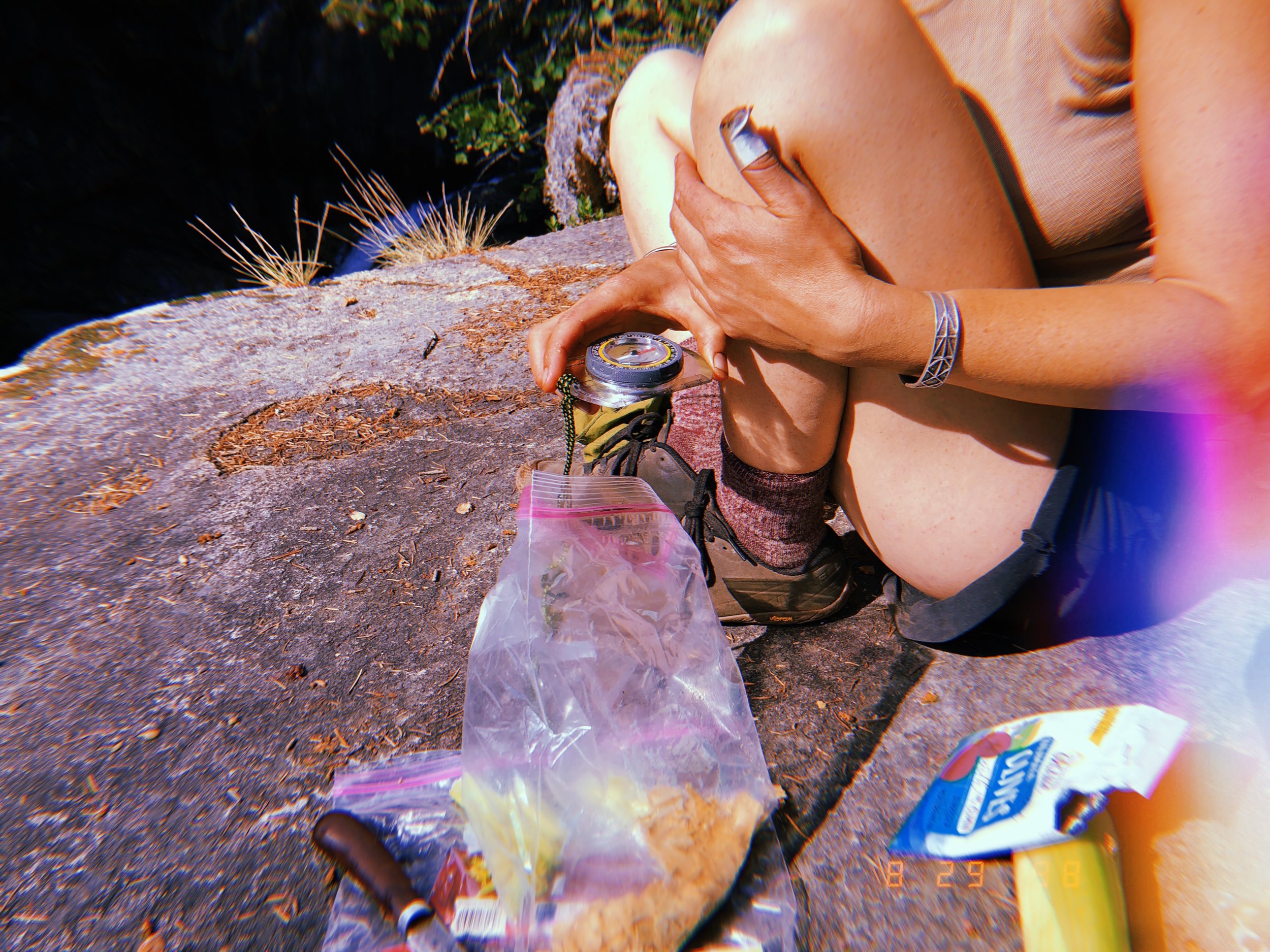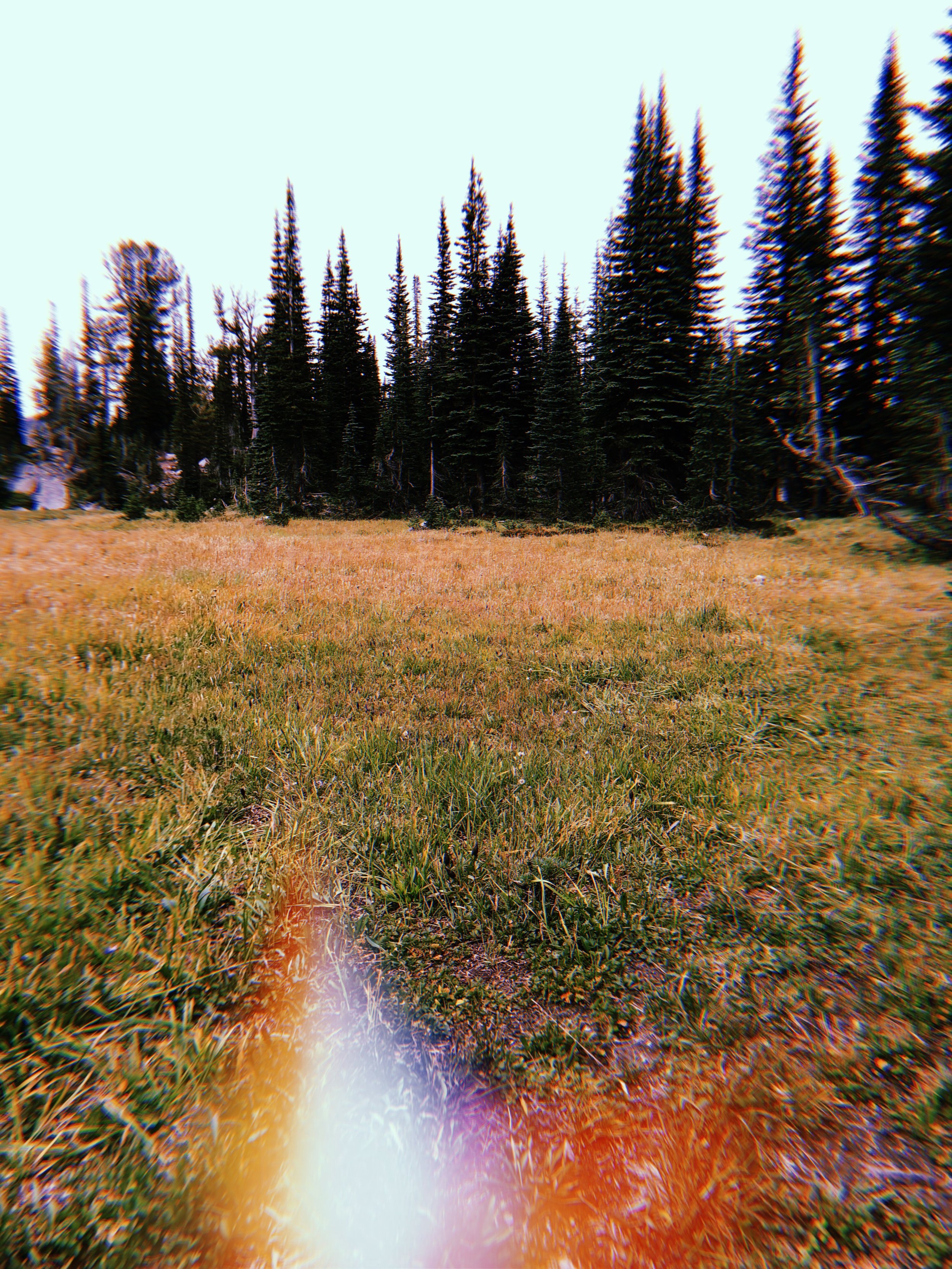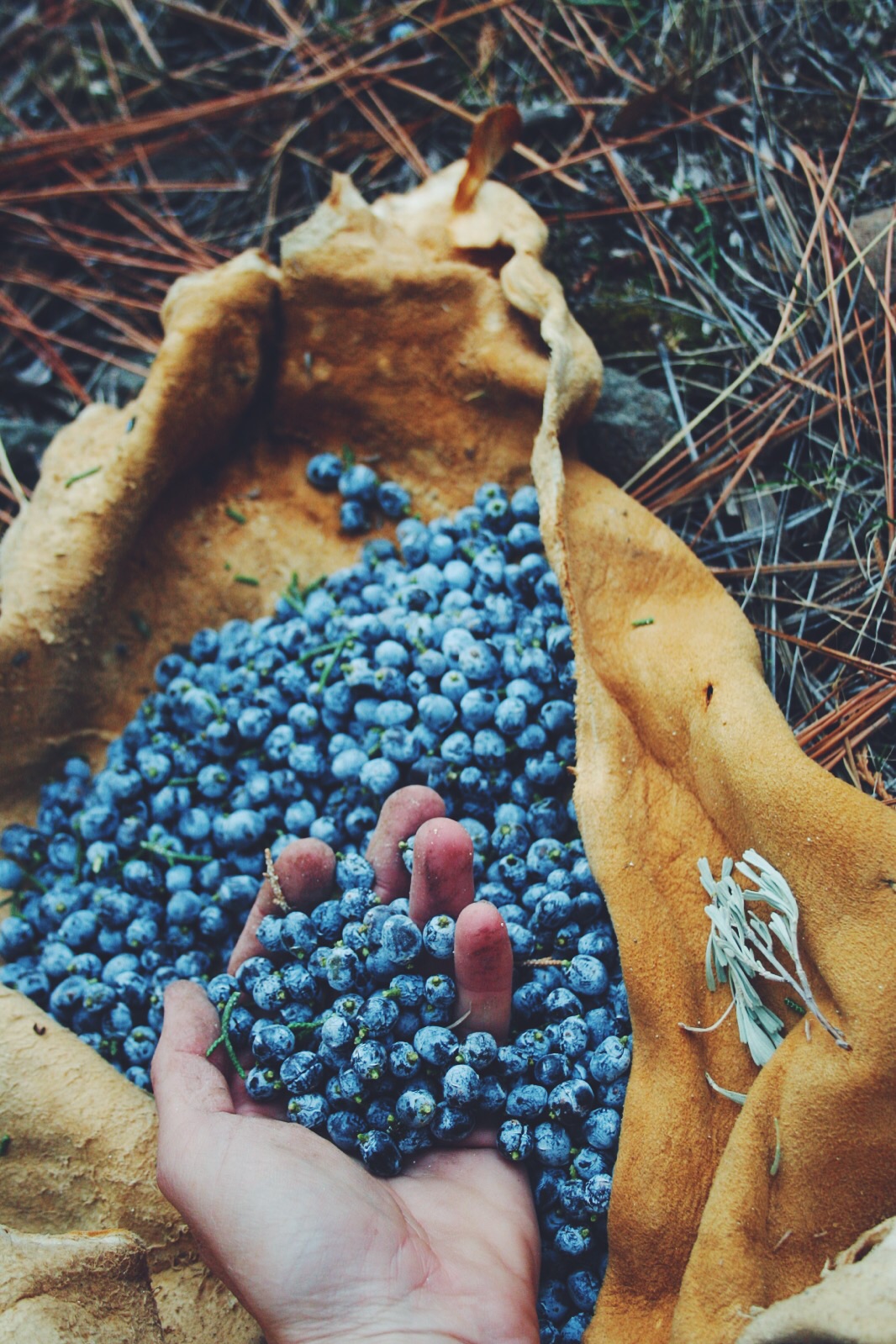I'm sitting in my camper on a windy and cool morning in Hood River, Oregon, after a couple days of occasional rain spurts gave some relief to dusty dry ground. Out my window I see plump hanging Blue Elderberries (Sambucus), Fir (Abies) and Douglas Fir (Pseudotsuga) trees all shades of green and cyano full of cones, Deerbrush (Ceanothus) worn and yellowing from a summer of hot sun, a Big-Leaf Maple (Acer) tree heavy with samaras. From it hangs a giant paper wasp's nest, bigger than two soccer balls, spiraling itself into a leaf covered limb.
Black Locust (Robinia) trees are carrying pea-like pods brown and ripening, with yellowing rounded leaflets as fall nears. Scotch Broom (Cytisus) weaves into the yellow field with small green foliage and even smaller black pea pods, rattling as one passes by them. A patch of Comfrey (Symphytum) is a green island in a sea of straw colored grass, parched from a dry summer of rare rains. A sprinkling of Walnut (Juglans) trees find themselves in the field along with Plums (Prunus) that have gone awry from dying back and the rootstock emerging in dominance to produce it's long hidden fruits. Pears (Pyrus), Plums (Prunus), Apples (Malus), Peaches (Prunus), Cherries (Prunus) dot the land or hillsides nearby.
Hood River seems to be the land of cultivated fruit. And majorly altered landscapes. But then there's also the Blackberries (Rubus) that reigned full, sweet and plump a month ago. The wild Saskatoons (Amelanchier) come up in open areas and Huckleberries grow (Vaccinium) under thick conifer cover where logging has not made its rounds in awhile (but soon enough they come for the trees).
The Manzanita (Arctostaphylos) up on the haphazardly denuded clearcuts are covered in rose-colored berry clusters, powdery when squished, containing small seeds inside. They hang against pale green foliage. I taste the powdered berry, sweet and tart flavors fill my mouth hunched over in full dry sunshine.
Every now and then a meat bee flies into my camper, checks out my stove for the hopes of meaty remnants, tries to get out through my window that doesn't open, swirls around again and then finds its way out the escape door of my camper window that lost it's screen last year when I drove off without securing it. It was a silly mistake after having to pry it open to break in, standing haphazardly on the seat of my bike to reach in after accidentally locking myself out.
Photo: Drying gleaned Plums in Hood River, Oregon.
Photo : making Blue Elderberry (Sambucus) and Oregon Grape (Mahonia) medicine in Hood River, Oregon.
I finally got to cleaning all the dust off of things in my camper after a whole summer during the dry season in the West having my back window fall open slowly on bumpy roads. After some focused attention, I got the windows to lock again. Finally, the dust and exhaust won't be filling my space and permeating my sheepskins, vintage cloth covered foam cushions, handmade pink silk curtains.
The light is coming in my wide windows, a lucky thing for a 1974 vintage camper, in spurts as dark clouds move around in the sky, threatening another welcomed sprinkle of moisture and mud.
I am here after taking a several week trip with my friend Erin into the Wallowa mountains of eastern Oregon, where we backpacked part of a route I walked last year with Signal Fire, revisiting a somewhat familiar place but in a different month, where the plants and land reflected a different energy.
(Most photos beyond this post were taken with an iphone and Huji cam app)
Photos above: Our first campsite in the Wallowas.
(Photos above: Camping at Heart Lake. Wild Onion, Gentian, Huckleberries, and more.)
Heart Lake.
Erin with Mugwort at our first campsite.
After that, we went and visited Jim Croft and Melody Eckroth, a couple of craftspeople who have lived off grid for exactly 41 years; the anniversary happened while we were there. I wrote a blog post on my time there last summer, working on hide tanning projects and making books with Jim. It is written in a bit of superfluous language, but is a glimpse nonetheless into their actual handcrafted world.
I am enjoying the quiet solitude here at Rahane, a land that is occupied by a small community of folks also living off grid in Hood River, but close to town and Portland-- a lot more 'in society' you would say than Jim and Melody's daily reality. I'm reflecting on my summer on the road, and appreciating the quiet simplicity of landing on a small farm with an abundance of vegetables and fruits, cool fall winds, a community atmosphere. I've found myself going majorly internal, and thinking about my winter desires of time in a cabin alone and working on my WORK and tending to my health, mind and body.
The trip to the Wallowas was a kind of pilgrimage to revisit a trail and campsites that impressed upon me greatly last summer when I did the trek with Signal Fire. I knew the lake I wanted to go to, I knew there'd be dried up Elephant’s Head (Pedicularis), yellowing wild Onions (Allium). I knew it would be rugged and intense. Erin agreed to go with me, despite having a lot of basket commissions to do, and projects to tend to herself. We both like getting out into the wilderness and getting away from the 'many' things we humans have to tend to in our society in order to survive, thrive, make some kind of difference.
We arrived after a day of travel coming from Hood River, (and here I am there again writing this), stopping in La Grande, Oregon, a familiar small town where we resupplied with Signal Fire. We did our last phone calls while having service, surveyed our maps once more, and headed out into the wild yellow-windblown hills to our chosen trailhead.
After hours of driving deeper in, we arrived and camped by a horse corral site. It was an area with a couple other campers and folks tucked away in that rugged wild realm. The coyote stories of the Nez Perce that we read while doing our walk last summer never cease to leave my mind when traversing through the mountains and terrain of the Wallowas.
Stories tend to attach themselves to places and make them come alive.
I took those stories with me once again and read them by evening headlamp tucked into my sleeping bag, or early in the morning when I'd wake and make coffee at 6 am.
(Photos above: preparing our food and clothing for backpacking, getting ready in my camper at the horse corral)
We packed enough food for a week even though we didn't plan on being there that long. I only took my smart phone and decided to capture any photographs of the trip only with the phone- no film, no DSLR. I used a 90's throw away camera film emulating app called Huji, to play around with a different energy, a different kind of photo diary. One that is fleeting, rough around the edges, artistic in a different kind of way. Using these filters and apps are a funny thing, though its pretty much the norm these days to try to recreate the nostalgia of ethereal film ways. We must collectively long for the days of slow reveal, of imperfection, of a non-digital reality, one not clouded by constant attention. But here I was, carrying along the smart phone, to use it as a journal of our time. SO this is why these photos have a funky look. I’m playing around with different ways to collect diaries for myself, and to share with others.
Photos above : watercolor and Gentian study. (Gentiana)
I did some drawing, watercolor play, and mostly lots of writing, my easiest go-to creative form when I am on such expeditions. All of this is my practice of watching place. In the past, I have been able to easily and seamlessly pop out botanical drawings, plant lists and ephemeral collage while working in place, reflecting on what wildness and disturbance and time looks like on the land where I am. But lately, it has been more of me writing, just simply watching. I switch between photography, making sun prints, using color to express the feeling of the place, working with the shapes of the organic things growing and moving through and more. Limits are important. The limits of being able to carry only a couple art supplies in, helped (and helps) me to focus.
Photos above: top, left to right: Rabbit Tobacco (Pseudognaphalium obtusifolium), Rabbit Tobacco & Mugwort (Artemisia sp.) & Yarrow (Achillea millefolium), Spruce (Picea sp.), Fir (Abies sp.).
The first night we camped by the creek in the bottom of the canyon we walked through. It was surrounded by a river plain and field dotted with tall Spruce trees whose limbs did not reach out very wide, a bear hang problem, one I remember we had on the Signal Fire trip last year too. We brought dehydrated vegetables from past gardens, seaweed we and our friends collected from the east or west coast, dried meat cakes and fish, dried Cherries, Apples and Persimmons (Diospyros) from our last gleaning expeditions. We made meals over a small camp stove, drinking hot tea with Ceanothus leaves in the evening (‘New Jersey Tea’), going to bed early with the sun. No fires were allowed, as a burn ban had just been initiated for the region.
Below- Ceanothus velutinus, Snowbush, Redroot. Top far left. Bottom far left: Amelanchier, Juneberry, Saskatoon berry)
We then ventured up to a high elevation lake, and took the less maintained trail up, one that was as steep as it can get, with a view that kept getting more epic, the higher we climbed. We criss-crossed creeks several times and witnessed the riparian eco-zone that followed it's snake like path. We saw Willows (Salix spp.), Alders (Alnus spp.), Angelica (Angelica sp.), Stinging Nettle (Urtica sp.), Osha (Ligusticum porteri) and more.
(Osha)
Up high, the air was brisk, clouds had settled in along with some frigid wind, but I still took a chance during a moment of sunshine to jump in the lake that we swam in last summer during the height of the long warm days. I owed it to my Signal Fire cohort to freeze my arse off, and jump in the cleansing deep water.
Erin proceeded to climb to the top of the nearby mountain peak pack off, without a headlamp, at dusk, because she said that she's the kind of person that 'needs to go up there on that rock' and tried for it (she made it).
I painted Gentian, saw deer eating wild onions at dusk, found old camper trash tucked in the conifer needles, hung our bear bag on the same White bark pine (Pinus albicaulis) that we used last summer because it was one of the only trees around with long limbs. Throwing the sharp rock up in the air and over the wide stretching branch, I remembered last summer when I did the same motion. I almost fell down the pointed knoll many times, full of rock shards, moss, baby Spruce (Picea) and White Bark pine (Pinus albicaulis) trees. In the distance, the sun set a brilliant orange on other mountains in the Wallowas, and the silence was utter bliss.
Erin of Kindred Craft.
Erin still was MIA, apparently making her way up the mountain across the way and barely getting to the top before the terrain turned utter steep gravel and she couldn't climb her way up anymore without sliding down to a dangerous injury. She came back, we made chicory tea with coconut fat frothed in it and tried to warm up. We had a restless night of sleep up at high elevation, both thinking about our lives, our relationships, our next moves, our projects in the world.
Immersion in the quiet can ignite total clarity, or confused feelings of seeing what is usually hidden underneath the noise of everyday life. If getting out into the 'wilderness' does anything, it simplifies the mind.
I put pine sap on my leg wounds made by passing briars and jutting rocks, and the dust from a dry summer sticks there and must be scrubbed off in frigid waters with sand.
We spot Osha, pull mature seeds off of tall umbels and plant them in disturbed ground.
We take time to pull up a small patch of invasive Canadian Thistle (Cirsium arvense), spread potentially by a single pile of horse manure.
We see lots of folks on the main trail the next day. We pass a jovial couple in their 80's on horseback, with an extra mule, going to their favorite lake. One of them had a cushioned neck brace.
We get out of the way for bow-hunters in camouflage with pack goats to carry out Elk as they capture food on their hunt. A couple of older cowboys ride by on horses, one horse spooked easily by our de-saddled packs. They told us to look out for their 'blue dog,' a blue heeler that we later saw lost after following another dog with a lone woman hiking going the opposite way.
Gooseberry (Ribes)
Mugwort (Artemesia)
I wish I could stay out there for a month or more. It takes time to adjust to the silence, to the elements, to how our nervous system wants to respond to spaces that feel 'wild.'
Wildness is so ethereal, subjective, really everywhere. But to me, the wildness found here is about being unobserved by other humans, about being at awe at the earth's doings.
The storm that rolls by, the morning dew, the flocks of birds, the raging river, the trees that grow out of rocks. These phenomena are everywhere, all over our resilient yet fragile planet. Putting myself here, I feel something in my body ease up.
At the same time, I felt an anxiety, that somehow I am 'wasting my time' not getting a real job, but choosing to walk out instead. The anxiety of capitalism, of churning, of running on a wheel, for what? A comfortable retirement? A place in a nursing home? The ability to buy all the newest gadgets when they come out so they break in a year and then sit in storage, forever plastic and obsolete?
Take me here in death, to the place where the coyotes will get me, to where the Poison Hemlock grows. Take to me where the mosquitoes are thick, the evening wind strong. The nights cold, the water frigid. I don't mind the dirt. I don't mind a cold bath that will take my breath away. Aliveness is really what it is. This sense of being a part of it all. This isn't 'untouched land' by any means. Plenty of humans have been here before and are still here. They just didn't take away that magic thing that feels good inside.




























































































































